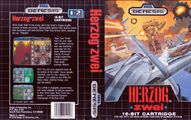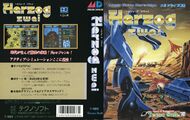Difference between revisions of "Herzog Zwei"
From Sega Retro
(→Legacy) |
|||
| Line 62: | Line 62: | ||
The U.S. game release packaging art was executed by veteran San Francisco game box illustrator Marc Ericksen, who had previously done the art for ''[[Thunder Force II]]'', and was invited back by Sega for this image, as it was considered a 'sister' game to ''TFII''.{{ref|http://www.mobygames.com/developer/sheet/view/developerId,25}}{{ref|http://www.mobygames.com/game/herzog-zwei}} A sequel was planned for Sega's [[Sega 32X|32X]] platform, but with the subsequent failure of that console, so, too, died the plans for a third ''Herzog'' title. With Technosoft closing its doors in [[2001 in gaming|2001]] and the status of the intellectual property being unknown, the future of the series is likely sealed. | The U.S. game release packaging art was executed by veteran San Francisco game box illustrator Marc Ericksen, who had previously done the art for ''[[Thunder Force II]]'', and was invited back by Sega for this image, as it was considered a 'sister' game to ''TFII''.{{ref|http://www.mobygames.com/developer/sheet/view/developerId,25}}{{ref|http://www.mobygames.com/game/herzog-zwei}} A sequel was planned for Sega's [[Sega 32X|32X]] platform, but with the subsequent failure of that console, so, too, died the plans for a third ''Herzog'' title. With Technosoft closing its doors in [[2001 in gaming|2001]] and the status of the intellectual property being unknown, the future of the series is likely sealed. | ||
| − | ''Herzog Zwei'' went on to influence future RTS games, particularly ''[[Dune II]]'' (1992), | + | ''Herzog Zwei'' went on to influence future RTS games, particularly ''[[Dune II]]'' (1992), {{ref|http://planetcnc.gamespy.com/View.php?view=Articles.Detail&id=524}}{{ref|http://web.archive.org/web/20120402052714/http://www.nowgamer.com/print/feature/184}} the producers of which acknowledged ''Herzog Zwei'' as an influence,{{ref|https://web.archive.org/web/20030504034920/http://www.above-the-garage.com/rblts/vie16b.htm}}{{ref|http://www.edge-online.com/features/the-making-of-dune-ii/}}. |
| − | |||
| − | |||
| − | |||
| − | |||
| − | |||
| − | |||
==Physical Scans== | ==Physical Scans== | ||
Revision as of 14:25, 30 January 2016
| This article needs cleanup. This article needs to be edited to conform to a higher standard of article quality. After the article has been cleaned up, you may remove this message. For help, see the How to Edit a Page article. |
| Herzog Zwei | |||||
|---|---|---|---|---|---|
| System(s): Sega Mega Drive | |||||
| Publisher: Technosoft | |||||
| Developer: Technosoft | |||||
| Genre: Simulation | |||||
| Number of players: 1-2 | |||||
|
Herzog Zwei (ヘルツォーク・ツヴァイ) is a video game developed by Technosoft, released exclusively for the Sega Mega Drive in 1989, and a sequel to Herzog, which was released only in Japan for the MSX and PC-8801 in 1988. It was published in Japan by Technosoft in 1989 and in North America and Europe by Sega in 1990.
Herzog Zwei is often credited for creating the foundations of the real time strategy genre. The player controls a unit which can freely transform from a plane to a robot, and must create and transport units to capture structures and destroy enemy bases.
Overview
Herzog Zwei combined the gameplay of Technosoft's Thunder Force series with a fairly easy-to-grasp level of strategy gameplay. It differed significantly from both turn-based strategy and real-time tactics, and is the earliest example of a modern real-time strategy game.[1] Along with a single-player mode, it featured a split-screen two-player mode where both players are in action simultaneously and there are no pauses while decisions are taken, forcing players to think quickly while on the move. Though the player only controls one unit, a transforming mech, the manner of control foreshadowed the point-and-click mechanic of later games. It introduced much of the genre conventions, including unit construction and resource management, with the control and destruction of bases being an important aspect of the game, as were the economic/production aspects of those bases.[1]
Upon release, the game received little mainstream recognition, and its novel approach to strategy gameplay polarized critics who were uncertain about what to make of it. It was generally well received by Japanese[2] and European critics. Reactions from North American critics, however, were generally negative, with Electronic Gaming Monthly criticizing it for being too complex, judging it as a flawed shooter rather than a novel strategy game, and giving it some of its lowest review scores for a Mega Drive game.
Herzog Zwei has been considered one of the best two-player Mega Drive games and listed among the best games of all time, by Electronic Gaming Monthly, IGN and Next Generation.[3][4][5] It has been credited with laying the foundations for the real-time strategy (RTS) genre, predating and influencing the genre-popularizing Dune II.[6][7]
It is also retrospectively considered a precursor to the multiplayer online battle arena (MOBA) genre, which uses a similar formula of each player controlling a single command unit in one of two opposing sides on a battlefield.[8][9][10] Herzog Zwei has been listed as one of the most important games ever made by 1UP, while GameSpy listed it as one of the most underrated games of all time.[1][11]
Production Credits
- Main Program: Takashi Iwanaga
- Weapon Program: Haruhiko Ohtsuka
- Map Design: Osamu Tsujikawa
- Character Design: Izumi Fukuda
- Demo Program: Izumi Fukuda
- Music Compose: Naosuke Arai, Tomomi Ohtani
- Sound Effect: Naosuke Arai, Tomomi Ohtani
- Manual Writer:Fumio Sugano
- Herzog: T. O.
- Special Thanks: Marie Hughes, Kamometei
- Copyright: Tecno Soft
Reception
Upon release, Herzog Zwei was not very commercially successful and received little mainstream recognition, due to its lack of marketing, relatively early release on the Mega Drive platform,[1] and non-arcade genre on what was considered an arcade-oriented game console.
It is often found on several "best of" lists of video games, owing to its precedence in the real-time strategy genre, as well to the increasing understanding of finer points of its mechanics. [1][4]
Legacy
The U.S. game release packaging art was executed by veteran San Francisco game box illustrator Marc Ericksen, who had previously done the art for Thunder Force II, and was invited back by Sega for this image, as it was considered a 'sister' game to TFII.[12][13] A sequel was planned for Sega's 32X platform, but with the subsequent failure of that console, so, too, died the plans for a third Herzog title. With Technosoft closing its doors in 2001 and the status of the intellectual property being unknown, the future of the series is likely sealed.
Herzog Zwei went on to influence future RTS games, particularly Dune II (1992), [14][15] the producers of which acknowledged Herzog Zwei as an influence,[16][17].
Physical Scans
| 70 | |
|---|---|
| Based on 31 reviews | |
| Mega Drive, CA |
|---|
|
References
- ↑ 1.0 1.1 1.2 1.3 1.4 http://www.1up.com/features/essential-50-herzog-zwei
- ↑ http://www.famitsu.com/cominy/?m=pc&a=page_h_title&title_id=2579
- ↑ http://kisrael.com/vgames/powerlist/egm100.html
- ↑ 4.0 4.1 http://top100.ign.com/2005/091-100.html
- ↑ http://classicgaming.gamespy.com/View.php?view=GameMuseum.Detail&id=242 (Wayback Machine: 2007-11-23 00:25)
- ↑ http://www.above-the-garage.com/blog/1998/8/18/the-origin-of-realtime-strategy-games-on-the-pc
- ↑ http://www.edge-online.com/features/the-making-of-dune-ii/ (Wayback Machine: 2013-02-12 08:11)
- ↑ http://www.destructoid.com/review-airmech-242461.phtml
- ↑ http://www.mcvuk.com/news/read/moba-the-story-so-far/0133335
- ↑ http://www.gamesradar.com/ask-gr-anything-whats-moba/
- ↑ http://archive.gamespy.com/articles/september03/25underrated/index19.shtml (Wayback Machine: 2012-01-23 09:16)
- ↑ http://www.mobygames.com/developer/sheet/view/developerId,25
- ↑ http://www.mobygames.com/game/herzog-zwei
- ↑ [ ]
- ↑ http://www.nowgamer.com/print/feature/184 (Wayback Machine: 2012-04-02 05:27)
- ↑ http://www.above-the-garage.com/rblts/vie16b.htm (Wayback Machine: 2003-05-04 03:49)
- ↑ http://www.edge-online.com/features/the-making-of-dune-ii/
- ↑ 18.0 18.1 File:CGtC UK 04.pdf, page 31 Cite error: Invalid
<ref>tag; name ":File:CGtC UK 04.pdf_p31" defined multiple times with different content - ↑ 19.0 19.1 File:CVG UK 101.pdf, page 103 Cite error: Invalid
<ref>tag; name ":File:CVG UK 101.pdf_p103" defined multiple times with different content - ↑ File:EGM US 015.pdf, page 85
- ↑ File:EGM US BuyersGuide 1993.pdf, page 46
- ↑ 22.0 22.1 File:TGM UK 28.pdf, page 50 Cite error: Invalid
<ref>tag; name ":File:TGM UK 28.pdf_p50" defined multiple times with different content - ↑ 23.0 23.1 File:Joystick FR 010.pdf, page 102 Cite error: Invalid
<ref>tag; name ":File:Joystick FR 010.pdf_p102" defined multiple times with different content - ↑ 24.0 24.1 File:MegaTech UK 01.pdf, page 78 Cite error: Invalid
<ref>tag; name ":File:MegaTech UK 01.pdf_p78" defined multiple times with different content - ↑ 25.0 25.1 File:PlayTime DE 1991-06.pdf, page 116 Cite error: Invalid
<ref>tag; name ":File:PlayTime DE 1991-06.pdf_p116" defined multiple times with different content - ↑ File:PowerPlay DE 025.pdf, page 121
- ↑ 27.0 27.1 File:Raze UK 05.pdf, page 58 Cite error: Invalid
<ref>tag; name ":File:Raze UK 05.pdf_p58" defined multiple times with different content - ↑ 28.0 28.1 File:SegaPro UK 03.pdf, page 61 Cite error: Invalid
<ref>tag; name ":File:SegaPro UK 03.pdf_p61" defined multiple times with different content - ↑ 1700 igr dlya Sega, "" (RU; 2001-xx-xx), page 95
- ↑ Aktueller Software Markt, "Avril 1990" (DE; 1990-03-30), page 78
- ↑ Beep! MegaDrive, "February 1990" (JP; 1990-01-08), page 69
- ↑ Console XS, "June/July 1992" (UK; 1992-04-23), page 130
- ↑ Cool Gamer, "9" (RU; 2002-10-13), page 102
- ↑ Electronic Gaming Monthly, "May 1990" (US; 1990-xx-xx), page 20
- ↑ Entsiklopediya luchshikh igr Sega. Vypusk 1, "" (RU; 1999-xx-xx), page 321
- ↑ Entsiklopediya luchshikh igr Sega. Vypusk 3, "" (RU; 2000-xx-xx), page 107
- ↑ Famitsu, "" (JP; 1989-xx-xx), page 1
- ↑ Game Informer, "May 1999" (US; 1999-0x-xx), page 72
- ↑ Igry Sega Luchshiye iz luchshikh. Vypusk 2, "" (RU; 2001-08-27), page 207
- ↑ Sega Mega Drive Advanced Gaming, "January 1993" (UK; 199x-xx-xx), page 63
- ↑ Mega Drive Fan, "May 1990" (JP; 1990-04-07), page 89
- ↑ Mega, "June 1993" (UK; 1993-05-20), page 20
- ↑ Mega, "August 1994" (UK; 1994-07-21), page 79
- ↑ Mean Machines Sega, "October 1992" (UK; 1992-09-xx), page 139
- ↑ Power Play, "4/90" (DE; 1990-03-16), page 123
- ↑ Sega Power, "July 1991" (UK; 1991-06-06), page 26
- ↑ Sega Power, "October 1991" (UK; 1991-09-05), page 53
- ↑ Sega Pro, "April 1993" (UK; 1993-03-11), page 66
- ↑ Sega Saturn Magazine, "September 1995" (JP; 1995-08-08), page 85
- ↑ Tricks 16 bit, "Tricks Sega Gold 800 igr" (RU; 1998-03-20), page 16
- ↑ User, "Noémvrios 1990" (GR; 1990-1x-xx), page 63
- Pages with reference errors
- Cleanup
- 1-2 player games
- Use romtable template
- All games
- Bad external reference
- Old-style rating (allgame)
- External rating reference
- Old-style rating (asm)
- Rating without PDF source
- Old-style rating (cgtc)
- Use magref
- Old-style rating (cvg)
- Old-style rating (egm)
- Old-style rating (egmbuyersguide)
- Old-style rating (famitsu)
- Old-style rating (gamesmachineuk)
- Old-style rating (gamespot)
- Old-style rating (insomnia)
- Old-style rating (joystick)
- Old-style rating (mdag)
- Old-style rating (mega)
- Old-style rating (megatech)
- Old-style rating (playtime)
- Old-style rating (pp)
- Old-style rating (raze)
- Old-style rating (sega16)
- Old-style rating (segapower)
- Old-style rating (segapro)
- Update ratings template
- 22 old ratings



